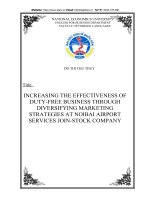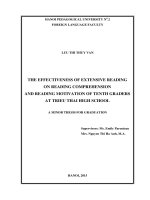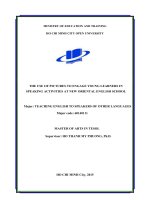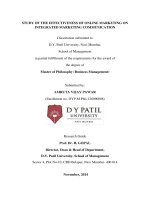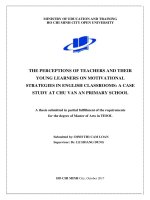The effectiveness of interactive whiteboards on young learners’ vocabulary learning at rise english center
Bạn đang xem bản rút gọn của tài liệu. Xem và tải ngay bản đầy đủ của tài liệu tại đây (832.43 KB, 27 trang )
University of Social Sciences & Humanities
Vietnamese Studies and Language Department
Group 1: Nguyễn Ngọc Châu
Nguyễn Mỹ Khánh
Phạm Phúc Khánh Minh
Nguyễn Trần Hoài Phương
Võ Thị Thanh Thư
Đỗ Thị Bạch Vân
10/2014
CHAPTER I: INTRODUCTION
1.1.
Background to the study
For years, Vietnamese style of learning English has mostly been following one direction:
information is transferred from teachers to learners. This is where teachers are the focus of the
classroom and teachers’ instructions and directions are automatically followed. In such context,
past technologies such as chalkboards, textbooks, notebooks, etc. have had a significant impact
on the way teachers deliver the information to learners.
However, the learning process, especially English language learning, needs more than that. One
of the most important criteria to assess the whole process of English language learning is the
learners’ outcome or, in other words, their ability to use English. Therefore, learners’
information, reactions, opinions, ideas, etc. have to be taken into account. Lessons need
designing in a way that both teachers and learners are the participants and there is interaction as
much as possible between them.
Nowadays, the development of information technology contributes a great deal to the English
language teaching and learning process. For example, multimedia slideshows, projectors, etc. are
getting more and more familiar to teachers and learners as they are applied to a large number of
schools. However, once again, the information still flows in one direction from teachers to
learners and the focus is still put on teachers since the majority of teachers cannot get out of the
slideshows. To solve this problem, new educational equipment which is called “Interactive
White Board” (IWB) has been introduced. This equipment is considered a breakthrough in
education and in English language learning because it is believed to promote the interaction
between teachers and learners and facilitate the learning process through its advanced
applications.
This new technology, with its advantages, is applied to vocabulary learning, one of the most
important aspects in English language learning. Harmer (1991) stated that, “If language
structures make up the skeleton of language, then it is vocabulary that provides the vital organs
and the flesh”. Therefore, English vocabulary is “an important area worthy of effort and
investigation” (Igbaria, 2005). Learning English vocabulary is not just about writing down the
new words and memorizing them. Teaching English vocabulary is not just about presenting and
1
introducing new words to learners. What teachers need to do is to make learners understand the
word meaning in context, how words are used and how to produce words in a correct way with
the correct pronunciation. This requires teachers to use effective teaching techniques and be
equipped with effective teaching aids. Using the IWB is one of the choices. However,
researchers are still trying to find out whether IWB, beside its special strength of promoting
interaction in classrooms, can also have a positive contribution to teaching and learning
vocabulary. There are many discussions and studies on this issue and some pointed out that the
IWB can do nothing more with vocabulary teaching and learning than just create the
environment. Findings also vary among different researchers in different situations.
This research is conducted on the primary learners at Rise Language Center, where IWBs are
used, thus it focuses on the specific context of the center. Does the IWB actually have a positive
impact on vocabulary learning at the center? How can it promote and facilitate this process? Is it
more than a toy? These questions bring the researchers to the idea of the research under the title
of “The effectiveness of interactive whiteboards on young learners’ vocabulary learning at Rise
English Center”.
1.2.
Aims of the study
The aim of this study is to find out whether or not it is significantly effective to use interactive
whiteboards on young learners’ English vocabulary learning at Rise English Center.
1.3.
Research questions
The two main questions of this research are “Does the use of interactive whiteboards have any
positive effects on young learners’ vocabulary learning at Rise English Center? Is there a
significant difference between those learners who are taught by the use of IWBs and those who
are not?
1.4.
Hypotheses
There are two types of hypotheses which are based on the aim and questions of the study. They
are Null hypothesis (Ho) and Alternative hypothesis (H1) as follows:
Ho: IWB does not enhance young learners’ vocabulary learning.
2
H1: IWB enhances young learners’ vocabulary learning.
1.5.
Significance of the study
There is considerable significance of this study in young learners’ vocabulary learning through
IWB at Rise English Center.
1) This study will help the teachers of English decide whether to use the IWB in teaching
vocabulary and in which way they can effectively exploit the IWB in teaching
vocabulary.
2) By reading this study, teachers of English are expected to widely adopt IWB to involve
their students in learning with technology. The researchers hope this study will give a
contribution to vocabulary teaching and learning with the use of the IWB.
3) It is expected that this study be one of the references for other researchers in the same
field to get information about teaching vocabulary using IWB.
4) The researchers will indirectly enlarge their knowledge and get experience by conducting
this research.
1.6.
Scope of the study
IWB is being used extensively in primary schools and English centers in Vietnam. The objective
of this study is to find out whether or not it is significantly effective to teach lexical items using
IWB to primary students of Rise English Center.
Hence, the study is carried out in Rise English Center in District 1, Ho Chi Minh City, Vietnam.
Due to the lack of time and the limited framework, the study only focuses on the use of IWB in
learning vocabulary and the other related aspects will not be revealed during the research.
Hopefully, the findings of the study will reflect the actual situation and help the researchers find
out the effective recommendations for the teaching of vocabulary using IWB.
1.7.
Organization of the study
The study is divided into five chapters:
Chapter one is the introduction to the entire study, which covers the background, aims, research
questions, hypotheses, significance and scope of the study.
3
Chapter two reviews the literature, which is concerned with all the technical terms of the study.
Chapter three introduces the methodology which the researchers follow for the whole study.
Chapter four is the results and discussion which focuses much on the analysis of the data
collected from Rise Language Center, the discussion of the results and the findings of the study.
Chapter five is the final words to conclude the whole work with the researchers’ suggestions and
recommendations to help improve the situation.
4
CHAPTER II: LITERATURE REVIEW
Nowadays, technology has been developing in a great deal and influenced many aspects of life,
including education. Using new and contemporary technology is considered as a practical
method to teach English as a second language. Specifically, IWB has been applied in teaching
English in many developing countries, including Vietnam. This approach is somehow foreign to
teachers in general, but it proves some effectiveness on teaching and learning activities,
especially teaching and learning vocabulary.
“IWB is a large interactive display that connects to a computer. A projector projects the
computer's desktop onto the board's surface where users control the computer using a pen, finger,
stylus, or other device. The board is typically mounted to a wall or floor stand,” (Wikipedia). The
IWB is a giant sensitive board that is connected to a computer and digital projector, which
reflects the computer’s image onto a big touchable computer screen controlled electronic pen or
finger (Vetter, 2009). Besides, Tataroglu and Erduran (2010) noted that we can access any
software program or Internet projected onto the whiteboard.
According to Oxford dictionary, vocabulary is “the body of words used in a particular language.”
Furthermore, Meriam-webster dictionary also has a similar definition to one from Oxford,
“vocabulary means the words that make up a language.” However, Macmillan dictionary
suggests another definition for this term, which relates to “all the words a person knows.” For
these reasons, teachers of English should keep in mind that there is no absolute definition for the
term. What is more important is the methods of teaching words to learners, and how the teachers
apply useful and appropriate methods effectively.
In 2003, the 5th World Conference on Educational Sciences introduced a research of Haruethai
Katwibun from Chiangmai University, Thailand. The research called Using an interactive
whiteboard in vocabulary teaching was conducted in a public school in Thailand, examining the
lesson plans of the teachers using IWBs, the students’ participation and the teachers’ postteaching notes. After doing surveys, observing the students’ participation, and decoding video
recordings, the researcher assessed the results on a 4 rating scales of response. At the end, the
researcher concluded that after using the IWB, the students’ vocabulary knowledge, engagement
5
and attitude were at a very good level, showing a clear effectiveness in teaching English
vocabulary by using IWB at school.
In 2004, Gary Beauchamp from University of Wales Swansea, United Kingdom published a
research called Teacher Use of the Interactive Whiteboard in Primary Schools: towards an
effective transition framework. The study was taken place in recently built primary schools in
which IWBs are used in every classroom throughout the curriculum. The school teachers and the
staff also received training for applying the IWBs into teaching activities. After that, the
researcher observed the lessons using IWBs by teachers from different classes of the school. In
the conclusion, the researcher suggested that using IWBs is possible to develop a framework and
model in teaching English to young learners. Furthermore, the study emphasized that long term
training for teachers is also significant in order to enhance their confidence and help them be
used to using IWBs in teaching activities more. As a result, the teachers will find themselves
more comfortable when working with children and IWBs, which will certainly improve the
effectiveness of teaching activities.
In 2005, the British Educational Communications and Technology Agency conducted a study
named How can the use of an interactive whiteboard enhance the nature of teaching and
learning in secondary mathematics and modern foreign languages? In this study, the research
team The research team, led by Dave Miller, comprises Doug Averis, Victoria Door and
Professor Derek Glover, who are all full-time lecturers in the Department of Education at Keele
University. The research suggested that IWBs can provide positive effects on teaching and
learning (Becta, 2003). They have shown that, if teachers are aware of the ways in which IWBs
can be used to support various learning styles, their use promotes the students’ interests,
encourages more sustained concentration, and leads to more effective learning. In the scope of
this research, the researchers also have discussion about pedagogy, engagement, socio-cultural
aspects, and technology. Moreover, the team raised some suggestions and recommendations
relating to this topic, concerning the situations, the ability of schools and teachers, equipment
maintenance, and training for teachers in the future.
Discussing both theoretical and practical aspects relating to using IWB in teaching English in
2012, Štěpánka Březinová from Czech Republic, University of Pardubice, Faculty of Arts and
Philosophy, conducted a research named Using the Interactive Whiteboards in Teaching
6
Vocabulary in ELT. For the theoretical part of the study, the research considered the students in
terms of age, development and learning styles. Another factor that the researcher discussed was
elaboration of technology in teaching, particularly IWB, considering its advantages and
disadvantages. At the end of this part, the author focused on teaching vocabulary, considering its
importance and ways of learning it. The researcher concluded that IWBs have made the
vocabulary teaching and learning activities more exciting and interesting to both teachers and
students with different learning styles.
Focusing on the practical aspect of this study, the researchers introduced the environment that
was used to conduct the study, the school, the students involved. In this part, lesson plans using
IWB were analyzed, considering such factors as the class size, how well the lesson plans were
prepared, and students’ reactions when using IWB in class. To sum up, the researcher pointed
out that IWB has a good effect on learning activities in class; however, it depends on the
teachers’ ability to keep their students’ interests and motivation from fading away. In conclusion,
the researcher suggested that IWB brings up more enthusiasm and interest of students into
learning.
7
CHAPTER III: METHODOLOGY
3.1.
Research questions
The aim of this study is to investigate the effectiveness of using IWB to improve the vocabulary
competence of young students at Rise English Center. Thus, the researchers focused on the
relationship between the use of IWB and young student’s vocabulary acquisition in order to find
out the beneficial ways to apply IWB in teaching vocabulary for young learners.
The research design in this study is to answer two questions:
1. Does the use of interactive whiteboards have any positive effects on young learners’
vocabulary learning at Rise English Center?
2. Is there a significant difference between those learners who are taught by the use of IWBs
and those who are not?
Based on the research questions, the null hypothesis was formulated:
Ho: IWB does not enhance young learners’ vocabulary learning.
3.2.
Research methods
In doing this study, the researchers used the experimental method based on pre-test and post-test
design. The researchers randomly selected the students whose ages range from 6 to 8 of Rise
English Center as the subject of the study. A pretest was given to each group to match the
groups. After that, they were randomly assigned into two groups. One group would receive the
experimental treatment while the other would not. After the treatment, the post-test scores of two
groups are compared to see the effectiveness of the treatment in the experiment group. There are
two kinds of variables; they are independent variable and dependent variable. The independent
variable in this study is the use of IWB in teaching vocabulary and the dependent variable of this
study is the students’ scores in the vocabulary test.
8
3.3.
Research context
Rise English Center has challenged to develop new a new curriculum in which the content of the
lesson has been integrated and linked to teaching methodologies and interactive learning
technologies. The goal of this new curriculum is to help children learn English and become more
fluent and confident English speakers. In addition, at Rise, children are trained and nurtured to
become independent learners equipped with the skills and abilities required for the challenges of
the 21st century workplace. Students are challenged to use technology to learn vocabulary as well
as other subjects. Linking technology especially IWB to learning vocabulary offers a profound
method to trigger and develop students’ interest in learning English at the early age of schooling.
The new as well as modern development of teaching method based on using IWB not only
motivates but also encourages students’ curiosity in exploring new knowledge particularly the
new language besides their first language.
3.4.
Participants and procedures
At Rise Language Center, the students are divided into three levels: Pre-Kindergarten (Pre-K) at
the age of 3-5, Kindergarten (KI) at the age of 4 -6 and Secondary 1 (S1) at the age of 6 – 8. For
the population of this study, the researchers chose the students at S1 level of Rise English Center
in the year of 2014. In this case, there would be four classes whose class code respectively is S1
– 0114 with 10 students, S1 – 0214 with14 students, S1 – 0414 with 13 students and S1 – 0714
with 13 students randomly chosen. After selecting the classes, the researchers gave a pretest to
the students from the four classes and then matched based on their similar scores. From this step,
11 pairs of students were chosen. Then, the researchers assigned the students into a control group
and an experimental group.
In this study, the experimental and control groups attended English classes four hours per week,
and received one month of instruction. During the course, the students received two different
types of instructions. One was provided with traditional methods of teaching vocabulary while
the other was provided with the use of IWB.
3.5.
Research Tools
Questionnaire is the central tool of this quantitative research. The researchers gave the test to
measure the students’ vocabulary in using the IWB in comparison with the traditional white
board. The participants were asked to do the test twice before the treatment (pre-test) and after
9
the treatment (post-test). The test items in the pre-test and post-test were exactly the same in the
content, but different in the format.
The test is a short examination of memory consisting of 20 focused questions. The participants
answered them by choosing suitable pictures or words that match the questions. In other words,
it was in the form of the multiple choice test with 20 items and the students had 20 minutes to do
the test. The score was based on a 0-10 scale.
3.6.
Data Collection Procedure
The researchers randomly selected students from Rise English Center. In order to match the
groups, the researchers gave a pretest to each group. The scores of each individual in the group
were collected for the first time. Given the results of the pretest, the researchers matched based
on their similar scores.
After taking the pretest, one group would receive the experimental treatment (experimental
group) while the other would not receive it (control group). The experimental group was taught
vocabulary on the IWB; the control group was taught on the traditional white board. After one
month of learning new lessons, the two groups then took their second test. The researchers used
the test to know the students’ ability in learning vocabulary. The result obtained from the posttest was collected, calculated and analyzed.
During the testing time, rooms for the two groups were exactly the same in terms of size and
facilities. In addition, the participants of each group were taught new lessons by the same
teacher.
3.7.
Data analysis procedure
To make a comparison of two means for two groups after the treatment, the researchers used
paired t-test. In order to obtain the t value (t), the researchers calculated the Standard Deviation
(SD) and the standard deviation of the differences ( S D )
The formula of standard deviation, standard deviation of the differences and the paired t-test are
as follows:
SD
=
1
2
D 2 D
n
n 1
In which:
10
D
: the difference between the scores on each pair (D = X1 – X2)
n
: the number of the pairs
SD
=
SD
n
Then, the data will be categorized into:
(1) the students’ pretest mean score in the experimental and control groups (X),
(2) the students’ post-test scores in the experimental group (X1),
(3) the students’ post-test scores in the control group (X2)
t=
X1 X 2
SD
and the descriptive statistical analysis will be performed to provide comparisons.
11
CHAPTER IV: RESULTS AND DISCUSSIONS
4.1.
Analysis of data
Following the collection of data of the post-test in the experimental group and control
group, the researchers started to analyze them by using the paired t-test. The researchers
calculated the paired t-test to find out whether or not it was effective to use IWB in teaching
vocabulary to young learners of Rise English Center.
The table below presents the specific calculation in more detail.
THE RESULT OF CALCULATION
Number
of pairs
Pre-test
scores
1
2
3
4
5
6
7
8
9
10
11
5
7
7
3
6
6.5
4.5
6
6
5.5
8
∑= 64.5
X = 5.86
Post-test scores
Experimental group (X1)
8
10
9.5
6.5
9
9
6
8.5
9
7
10
∑= 92.5
X 1= 8.41
Control Group (X2)
6.5
8
8
5
7.5
8
7
7
7.5
7
9.5
∑= 81
X 2= 7.36
D
(X1-X2)
D2
(X1-X2)2
1.5
2
1.5
1.5
1.5
1
-1
1.5
1.5
0
0.5
∑= 11.5
2.25
4
2.25
2.25
2.25
1
1
2.25
2.25
0
0.25
∑= 19.75
The results of the calculation included:
(1) the students’ pretest mean score in the experimental and control groups ( X = 5.86);
(2) the students’ post-test scores in the experimental group ( X 1= 8.41);
(3) the students’ post-test scores in the control group ( X 2 =7.36);
Before finding the result of paired t-test, the researchers calculated the standard deviation
first. The data were fitted into the standard deviation formula as follows:
12
SD
1
2
D 2 D
n
=
n 1
=
1
2
19.75 11.5
11
= 0.88
11 1
The standard deviation of differences between means of the two groups was calculated.
SD
SD
=
n
=
0.88
11
= 0.27
As a result, the researchers obtained the t value.
t=
X 1 X 2 8.41 7.36
=
= 3.89
SD
0.27
This t value (t= 3.89) was higher than the critical value with 10 degrees of freedom that is
1.812.Therefore, it can be concluded that H0 was rejected and H1 was accepted at the 0.05 level
of significance.
4.2.
Discussion of results
Based on the above results, the researchers came to the conclusion that the adoption of
IWB was effective in teaching vocabulary to young learners of Rise English Center. The
students’ vocabulary learning ability prior to the use of IWB was found to be at the average
level. After being taught through IWB, their ability was at a higher level. In other words, there
was a considerable improvement in the students’ achievement in vocabulary after the treatment.
This means that teaching vocabulary through IWB could enhance their learning vocabulary.
The result of the calculation of the paired t-test was 3.89 and it is higher than the t-critical
value (1.812) with 10 degrees of freedom. Hence, it could be said that the score of experimental
group ( X 1 = 8.41) were significantly different from the score of control group ( X 2 = 7.36). It
means that there was a significant difference between the students who were taught by using
IWB and those who were not. Consequently, IWB can be viewed as a useful means in teaching
vocabulary at Rise English center.
13
CHAPTER V: CONCLUSIONS AND IMPLICATION
5.1.
Conclusions
Based on the data analysis of the study, it can be concluded that there is a significant
difference between the learners’ vocabulary competence in the experimental group and the
control group. The differences of scores in the experimental and control groups are confirmed
through the matched t-test.
The significant difference between the two groups can be seen from the t-obtained and
its critical value. From the data analysis, it can be seen that the result of the calculation of the
matched t-test formula is 3.89 which is much higher than the t-critical value (1.812). Therefore,
it can be concluded that the alternative hypothesis (Ha) with 0.95 or 95% of significance level is
accepted and null hypothesis (Ho) is rejected. In other words, it is effective to teach vocabulary
by using IWBs to the primary learners at Rise Language Center.
5.2.
Implications
Future researchers are expected to do with a similar topic by using a larger population;
consequently, the result will be more applicable to a wider range of teaching vocabulary.
14
References
Igbaria, A. K.(2005). Teaching English Vocabulary. New York: Houghton Mifflin Company.
Harmer, J.(1991). The Practice of English Language Teaching. New York: Longman.
Březinová, Š.(2012). Using the Interactive Whiteboards in Teaching Vocabulary in ELT.
Katwibun, H.(2003). Using an interactive whiteboard in vocabulary teaching. Chiangmai
University, Thailand.
Beauchamp, G. (2004). Teacher Use of the Interactive Whiteboard in Primary Schools: towards
an effective transition framework. University of Wales Swansea, United Kingdom.
The British Educational Communications and Technology Agency. (2005). How can the use of
an interactive whiteboard enhance the nature of teaching and learning in secondary
mathematics and modern foreign languages?
15
VOCABULARY TEST
TIME
: 20 MINUTES
TOTAL MARK
: 10
Question 1: Choose the picture that matches the word – ORANGES
Question 2: Choose the picture that matches the word – TOOTHPASTE
Question 3: Choose the picture that matches the word - EGGS
16
Question 4: Choose the sign that matches the animal in the zoo – OWL
Question 5: Choose the sign that matches the animal in the zoo – LION
Question 6: Choose the sign that matches the animal in the zoo – CAMEL
Question 7: Which of these is a letter?
17
Question 8: Which of these is a question mark?
Question 9: Choose the word that makes from the letters – (E – H – T)
A. hat
B. the
C. tar
D. eat
Question 10: Which word that makes from the letters? – (A – T – C)
A. hat
B. tip
C. cap
D. cat
Question 11: Which of these is a word?
cat
18
Question 12: Choose the sign for the market
Question 13: Choose the sign for the bus stop
Question 14: Choose the sign for the stop sign
19
Question 15: Choose the sign for the zoo
Question 16: Which of a thing that would not belong to metal group
Question 17: Which of a thing that goes to paper recycling bin?
Question 18: Which of a thing that would not belong to compost pile?
20
Question 19: Which of a thing that goes to glass recycling bin?
Question 20: Which word that rhymes with this word – PAN?
A. MAN
B. CAT
C. PEN
D. PAT
21
VOCABULARY TEST
TIME
: 20 MINUTES
TOTAL MARK
: 10
Question 1: Circle –
A. apple
B. orange
C. grape
D. banana
Question 2: Circle –
A. toothpaste
B. toothbrush
C. box
D. cereal
Question 3: Circle
A. toothpaste
B. apples
C. egg
D. milk
Question 4: Circle
A. owl
B. tiger
C. lion
22
D. bird
Question 5: Circle
A. tiger
B. lion
C. owl
D. alligator
Question 6: Circle
A. camel
B. tiger
C. lion
D. donkey
Question 7: Circle
A. letter
B. shape
C. color
D. number
Question 8: Circle
A. question mark
B. letter
C. shape
D. number
23
Question 9: Choose the word that makes from the letters – (E – H – T)
A. hat
B. the
C. tar
D. eat
Question 10: Which word that makes from the letters? – (A – T – C)
A. hat
B. tip
C. cap
D. cat
Question 11: Circle
A. word
B. sentence
C. number
D. letter
Question 12: Circle
A. market
B. zoo
C. bus stop
D. zoo
Question 13: Circle
A. zoo
B. stop
C. parking lot
D. bus stop
Question 14: Circle
A. stop
B. recycling sign
C. bus stop
24
